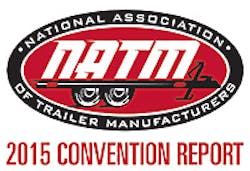The steel is talking—and it’s telling us how to learn from failures
YOU can’t listen to steel.
Or can you?
Duane K Miller, manager of engineering services and welding design consultant for the Lincoln Electric Company, believes you can.
“Steel does try to communicate with us,” he said. “And if we understand what those characteristics are about failures, that will help us understand the cost of failure and how to fix the problem. My goal is for all of you to become weld doctors.”
In “Listen to the Steel: Learning from Failures,” Miller recited a quote from Henry Petroski, a professor at Duke University who wrote “To Engineer is Human”:
Said Miller, “If we’re honest with ourselves, the lessons we learned best are ones that came from failures. The ones where you say, ‘I’m never going to do that again.’ You learned you don’t do that. We don’t have time to make all failures ourselves, so we learn from others.”
Miller showed photos of a number of cases of weld failure:
• Pumpjack.
He said his customer concluded that there was a welding problem because there was a weld near the fracture, but he said fractures can be a long way from the weld.
“On a windshield, the crack path is not important,” he said. “What’s important is the initiation point. That’s where it all starts and propagates from there. Cracks usually don’t start in the middle of an object. Crack-propagation paths tell you about the stress field.
“Beach marks tell us we’ve had cyclic loading that resulted in repeated deformation and fatigue. Fatigue occurred very, very slowly. Any time we do things slowly, we can usually be more deliberate and more careful, and so fatigue cracks tend to be very flat, because they’re taking thousands of cycles to form. They’re forming very, very slowly, but will leave behind beach marks as the crack expands. Now the good thing about beach marks is that if you track them back, you’ll find where the crack initiated. We can show up two seconds after somebody threw a pebble in a pond, but when you look at the circular rings coming back, you can say, ‘Oh, it looks like they put the rock in there.’
“A fifthwheel on a trailer has the same kind of detail, where you are transferring moment. The solution is to even out the distribution of stresses on this member. What’s the best way to do that? Adding stiffener at that location. We say that the design principle is to provide a member when forces change direction. By doing that, you even out the distribution on stresses, not only on the weld but also the flange.”
The lesson: “Provide a member when forces change directions.”
• Forklift.
Modifications were made to a forklift made at Lincoln—there was a unicorn structure to move rolls of wire.
“Here’s what one of my predecessors did to this piece of steel four inches thick: bored a hole through the steel and ran a heavy tube through the steel, and then put an uneven fillet weld. I’m sure their intention was trying to get the angle as flat as possible to the tube.”
The lesson: “Don’t put welds into bending. Welds are really good in tension. You start bending welds, that’s not so good. Try to keep welds out of bending. This could apply to trailer axles.”
• Front-end loader.
He said there usually a pair of arms, and between the arms is a circular or hollow section in between to give torsional resistance to the two arms so they work together instead of twisting.
In this case, an end user purchased a non-OEM attachment powered by hydraulic cylinders and needed to route hoses out to the front to keep them from flopping around, and he took a plate of steel a half-inch thick, drilled two holes, welded it into place, and bolted some brackets onto that plate.
“But in welding connections, there are no secondary members,” Miller said. “The steel thinks that that’s part of the load-bearing system. My customer designed an arm with no attachments with stresses flowing directly through that. Their customer welded on an attachment. These little attachments come back to haunt us. Some of the stress flows through the attachment, which isn’t really a problem. But the problem is that all the stress has to come out of the attachment. The solution: Don’t weld on attachments. They would have been far better off if they had drilled a hole and used a quick tie to hold those hoses. Or maybe clamped something directly onto the arm. You’ve had that happen to trailers where a user welded something on. They didn’t know what they were doing, but it created a problem. That’s why some of you write on your trailers, “Do not weld onto this.”
Lesson: “There are no secondary members in welded construction. You might not have designed that into your system, but it becomes a stress-bearing component when you do.” ♦
About the Author
Rick Weber
Associate Editor
Rick Weber has been an associate editor for Trailer/Body Builders since February 2000. A national award-winning sportswriter, he covered the Miami Dolphins for the Fort Myers News-Press following service with publications in California and Australia. He is a graduate of Penn State University.

